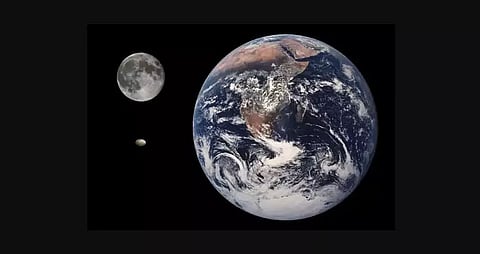
- Home
- Live Blog
- Breaking News
- Top Headlines
- Cities
- NE News
- Sentinel Media
- Sports
- Education
- Jobs

NEW YORK: The Moon played a huge role in the evolution of life on Earth as a new study suggests that our natural satellite once had a magnetic field that helped shield our home planet from harmful solar radiation during a critical early time.
The shared magnetic field situation, with Earth and Moon's magnetospheres joined, could have persisted from 4.1 to 3.5 billion years ago, according to the NASA-led study published in the journal Science Advances.
"The Moon seems to have presented a substantial protective barrier against the solar wind for the Earth, which was critical to Earth's ability to maintain its atmosphere during this time," said Jim Green, NASA's chief scientist and lead author of the new study.
Scientists have long known about Earth's magnetic field, which causes the beautifully coloured aurorae in the Arctic and Antarctic regions.
The new study simulated how the magnetic fields of the Earth and Moon behaved about four billion years ago.
Scientists created a computer model to look at the behaviour of the magnetic fields at two positions in their respective orbits.
At certain times, the Moon's magnetosphere would have served as a barrier to the harsh solar radiation raining down on the Earth-Moon system, the scientists wrote.
That is because, according to the model, the magnetospheres of the Moon and Earth would have been magnetically connected in the polar regions of each object.
Importantly for the evolution of Earth, the high-energy solar wind particles could not completely penetrate the coupled magnetic field and strip away the atmosphere.
But there was some atmospheric exchange, too. The extreme ultraviolet light from the Sun would have stripped electrons from neutral particles in Earth's uppermost atmosphere, making those particles charged and enabling them to travel to the Moon along the lunar magnetic field lines.
This may have contributed to the Moon maintaining a thin atmosphere at that time, too. The discovery of nitrogen in lunar rock samples support the idea that Earth's atmosphere, which is dominated by nitrogen, contributed to the Moon's ancient atmosphere and its crust.
Over time, as the Moon's interior cooled, our nearest neighbour lost its magnetosphere, and eventually its atmosphere.
The field must have diminished significantly 3.2 billion years ago, and vanished by about 1.5 billion years ago, said the study.
Without a magnetic field, the solar wind stripped the atmosphere away. This is also why Mars lost its atmosphere: Solar radiation stripped it away.
If our Moon played a role in shielding our planet from harmful radiation during a critical early time, then in a similar way, there may be other moons around terrestrial exoplanets in the galaxy that help preserve atmospheres for their host planets, and even contribute to habitable conditions, the scientists said. (IANS)
Also watch: IOC Contractual Workers Protest in Digboi